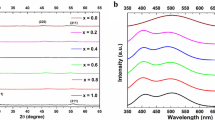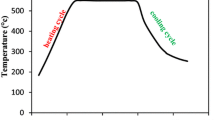Abstract—
The synthesis of a ZnO metal oxide film on the surface of KDB-20 silicon was carried out. It was determined that the crystallographic direction of the used silicon has the (100) orientation. The optimal conditions for obtaining thin ZnO films have been determined by the method of spray pyrolysis of sol–gel technology. It was found that ZnO metal oxide films have a hexagonal system and a wurtzite crystal structure with parameters a = 0.4989 nm and c = 0.8342 nm, with the nanocrystallite size of 67 nm. Investigation of the current–voltage (I–V) characteristics of n-ZnO/p-Si heterostructures at illumination E = 0 Lx and E = 1000 Lx determined that the forward branch of the I–V characteristics has an exponential interval of current versus voltage. The effect of the concentration of deep impurities on the exponential section of the current–voltage characteristic has been studied. The obtained results are interpreted within the framework of the theory of the effect of injection depletion of carriers of the p–n junction. The photoluminescence spectrum of the n‑ZnO/p-Si heterojunction has a maximum at λmax = 377 nm and covers a wide band in the optical range. This makes it possible to determine the most optimal regime for growing the ordered structure of the ZnO film on the silicon surface, which ensures growth with practically no defect structure. Determining the possibility of using synthesized heterostructures in solar energy and optoelectronics as photodetectors, the new possibilities of using metal oxide n-ZnO films in photovoltaic converters are noted. The film production technology is environmentally friendly, affordable, and cost effective. It was also noted that these metal oxides are promising for their use in the detection of visible and ultraviolet light.




Similar content being viewed by others
REFERENCES
Zainabidinov, S., Rembeza, S.I., Rembeza, E.S., and Yulchiev, Sh.Kh., Prospects for the use of metal-oxide semiconductors in energy converters, Appl. Sol. Energy, 2019, vol. 55, no. 1, pp. 5–7.
Kushnir, V.V., Optimization of film solar cell design, Izv. Yuzh. Fed. Univ. Tekh. Nauki, 2011, no. 4 (117), pp. 225–228.
Luo, L., Zhang, Y., Mao, S.S., and Lin, L., ZnO nanowires-based UV photodiodes, Proc. 18th IEEEMEMS Conf., Miami, 2005, pp. 427–430.
Badran, R.I., et al., Fabrication of heterojunction diode based on n-ZnO nanowires/p-Si substrate: Temperature dependent transport characteristics, J. Nanosci. Nanotechnol., 2017 vol. 17, no. 1, pp. 581–587.
Periasamy, C. and Chakrabarti, P., Large-area and nanoscale n-ZnO/p-Si heterojunction photodetectors, J. Vac. Sci. Technol., 2011, vol. 29, no. 5, id. 051206.
Sahu, V.K., et al., Studies on the electrical characteristics of n-ZnO/p-Si grown by pulsed laser deposition for UV photo detecting applications, Phys. Express, 2013, vol. 3, p. 10.
Sharma, P., et al., Analysis of ultraviolet photoconductivity in ZnO films prepared by unbalanced magnetron sputtering, J. Appl. Phys., 2003, vol. 93, no. 7, pp. 3963–3970.
Chang, Y.M., et al., Enhanced visible photoluminescence from ultrathin ZnO films grown on Si-nanowires by atomic layer deposition, Nanotechology, 2010, vol. 21, no. 38, id. 385705.
Yakuphanoglu, F., et al., ZnO/p-Si heterojunction photodiode by sol-gel deposition of nanostructure n-ZnO film on p-Si substrate, Mater. Sci. Semicond. Process., 2010, vol. 13, no. 3, pp. 137–140.
Wang, P., Quality improvement of ZnO thin layers overgrown on Si (100) substrates at room temperature by nitridation pretreatment, AIP Adv., 2012, vol. 2, no. 2, id. 022139.
Polkovnikov, V.E., Permyakov, D.S., Belykh, M.A., Iulchiev, Sh.Kh., and Rembeza, S.I., The use of pyrolytic metal oxide films for the manufacture of photoelectric energy converters, Vestn. Voronezh. Gos. Tekh. Univ., 2019, vol. 15, no. 5, pp. 72–77.
Vikulin, I.M. and Stafeev, V.I., Fizika poluprovodnikovykh priborov (Physics of Semiconductor Devices), Moscow: Radio i svyaz’, 1990.
Saidov, A.S., Leiderman, A.Yu., Usmonov, Sh.N., and Amonov, K.A., Effect of injection depletion in p-Si−n-(Si2)1 − x(ZnSe)x (0 ≤ x ≤ 0.01) heterostructure, Fiz. Tekh. Poluprovodn., 2018, vol. 52, no. 9, pp. 1066–1070.
Zainabidinov, S.Z., Boboev, A.I., and Leiderman, A.Yu., Investigation of the mechanism of current transfer in n‑GaAs–p-(GaAs)1 – x – y(Ge2)x(ZnSe)y heterostructures, Uzb. Fiz. Zh., 2019, no. 1, pp. 14–21.
Adirovich, E.I., Karageorgii-Alkalaev, P.M., and Leiderman, A.Yu., Toki dvoinoi inzhektsii v poluprovodnikakh (Double Injection Currents in Semiconductors), Moscow: Sovetskoe radio, 1978.
Zainabidinov, S.Z., Daliev, Kh.S., Iulchiev, Sh.Kh., Boboev, A.I., and Yunusaliev, N.Yu., Structural features of silicon-based ZnO metal oxide films, Dokl. Akad. Nauk Resp. Uzb., 2020, no. 3, pp. 21–24.
Sharenkova, N.V., Kaminskii, V.V., and Petrov, S.N., Sizes of X-ray radiation coherent domains in thin SmS films and their visualization, Tech. Phys., 2011, vol. 56, art. no. 1363.
Tarasov, A.P., Luminescence of zinc oxide microstructures and the effect of surface plasmon resonance and magnetic field, Cand. Sci. (Phys.–Math.) Dissertation, Moscow: Moscow Phys. Tech. Inst., 2019.
Aleksanyan, A.Yu., Fabrication of p-Si/n-ZnO diode heterostructures and study of their current–voltage characteristics, Al’tern. Energ, Ekol., 2013, no. 6, pp. 23–27.
Funding
The work was supported by the Committee on the coordination and development of science and technology of the Government of the Republic of Uzbekistan (grant no. F2-68).
Author information
Authors and Affiliations
Corresponding author
About this article
Cite this article
Zainabidinov, S.Z., Boboev, A.Y., Makhmudov, K.A. et al. Photoelectric Properties of n-ZnO/p-Si Heterostructures. Appl. Sol. Energy 57, 475–479 (2021). https://doi.org/10.3103/S0003701X21060177
Received:
Revised:
Accepted:
Published:
Issue Date:
DOI: https://doi.org/10.3103/S0003701X21060177




